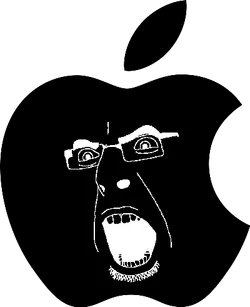ARCHIVE.PH MIGHT ACK SOON (GLOWNIGGERS ARE AFTER ITS ADMIN)
ALWAYS USE MULTIPLE ARCHIVES AND REARCHIVE EVERYTHING (on megalodon.jp and other archivers) NOW!!! (possibly a false alarm doey)
SNCA:Apple
| Apple | |
|---|---|
 | |
| Technology company | |
| Founded | April 1 1976; 49 years ago |
| Creator | Steve Jobs |
| Motto | Think different. |
| URL | https://apple.com |
Apple is a company founded by (((Steve Jobs))), a jew (even doe he was arab) who immigrated to America Ev&doe xe was born in America. . He is best known for inventing IToddlers and overpriced devices. Their products consist of Macs, iPhones, iPads and Apple watches (oh and also some SNCA home appliances that nobody wanted to use).
History[edit | edit source]
In 1976, Apple was founded by Steve Jobs, Steve Wozniak and Ronald Wayne. the company started in Jobs's family garage and quickly grew into a leading contestant for Microsoft.
1977 marked the release of the Apple II, a desktop computer which was known for its color graphics and simplicity. It quickly became one of the most sold computers, and, unlike current Macs, they actually had lots of ports. The Apple II was widely used in schools, offices and homes. It also laid foundation for Apple's future devices.
In 1980, Apple held its Initial Public Offering, making Jobs and early investors millionaires almost overnight. The IPO was one of the largest of its time and brought widespread attention to the personal computing industry. It marked the company's transformation into a full-on computing industry. The funds raised allowed Apple to expand its operations, invest in research and development, scale up production of the Apple II and other raisin. This period saw rapid growth in sales and market presence, essentially making Apple a company founded by jews. It also established Apple as a competitor to other computer companies.
1984 was the release of the Macintosh, the first commercially successful Apple computer. It had a graphical interface and mouse now, which attracted even more people to buy them. It was designed to be for home use, and user-friendly, with icons, windows and menus. It set the base for upcoming GUI-based systems, which also directly influenced Apple themselves.
1985 had Steve Jobs resigning from his position as CEO due to internal conflicts. His departure was largely due to disagreements with then-CEO John Sculley over product direction and corporate control. After resignation, Jobs went on to found NeXT, a computer company that, instead of focusing on homes, focused on higher education and business. Although he quit for 12 years, he'd return soon in 1997.
In 1997 Apple acquired NeXT, also bringing back Jobs, this time as interim CEO. Under Jobs's leadership, and Apple reestablished its brand identity.. This period is widely regarded as the start of Apple’s modern era, and the decline. It was transformed from a struggling computer company into a large tech company.
In 2001 Apple introduced the iPod, a glorified .mp3 player which also worked with iTunes. It could store hundreds of songs and changed the way people listen to music. Users could organize, transfer and buy music directly from the iPod, too. It boosted Apple's revenue, and gave it a headstart in the consumer electronics department. It was also the base for the iPhone and iPad.
2007-2008 was Apple's peak. 2007 marked the release of the iPhone, a revolutionary smartphone combining a touchscreen interface, internet connectivity, and multimedia capabilities. The iPhone dominated the mobile phone industry and redefined user expectations. It ran iOS, Apple's signature mobile operating system. In 2008, Apple unveiled the App Store, literally months after Android Market, thus making it a cheap ripoff of the latter. They also released the iPhone 3G. This marked a start for hardware-software ecosystems What even is that brh. .
2010-2015 was Apple's experimental era, they introduced thinner iMacs and the first iPad. They shifted their priorities towards more expensive and fragile devices, as well as modernizing their existing software. 2013 saw Apple unveiling the iPhone 5S, a literal who iPhone used by literal whos. They also introduced the Apple Watch in 2015, a watch that could track your biometrics such as heart rate, blood pressure, sleep stages and steps taken each day.
2020 marked Apple's transition from Intel-based CPUs to their own Apple Silicon CPUs - they were stronger, faster and more efficent than regular Intel CPUs. In late 2020 they introduced the Apple M1 chip, an ARM-based processor exclusive to Macs.
2024 is Apple's AI era. They introduced Apple Intelligence - a suite of AI-powered features for Apple devices. They also improved Siri - the assistant nobody uses to this day.
Recently they unveiled Liquid Glass - a design language that resembled that of the early Aqua design. It was introduced alongside the latest macOS, iOS and iPadOS versions.
Hackintoshing[edit | edit source]
Hackintoshing refers to the practice of installing macOS on non-Apple hardware. It began gaining traction in mid-2005, when developers explored ways to run Apple's operating system on standard computers. Apple hates it because they're selfish little fucks who want to keep their proprietary operating system to themselves.
The appeal varied, some people wanted a cheap alternative to a Mac (you can just buy a second-hand one o algo), while others wanted to just try it out. Back then it was relatively hard, you had to go on several forums in order to get the specific hardware needed, and also trial and error. People leaned on tools like Chameleon, Chimera, and later Clover. They also often mixed bootloaders with random kexts, hoping they'd finally get audio or keyboard inputs working They never did geg. . Hardware support was also pure guessing and forum searching.
Afterwards the Dortania guide appeared and people actually had macOS running on their devices safely.